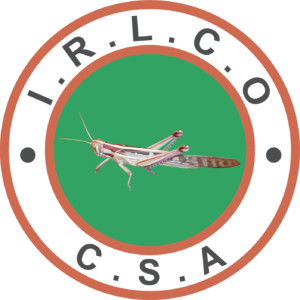Zambia
In 2024, the International Red Locust Control Organisation for Central and Southern Africa (IRLCO-CSA) in partnership with the Ministry of Agriculture conducted aerial surveys from 10 June to 2 July 2024 across the Kafue Flats, Simalaha Plains, and Lukanga Swamps to assess the threat of Red Locusts (Nomadacris septemfasciata) and African Migratory Locusts (Locusta migratoria migratoriodes).
The surveys aimed to evaluate Locust populations and their potential impact on nearby crops, including sugarcane, wheat, and maize.

By identifying areas in need of immediate control, the mission helped prevent Locusts from spreading to other provinces and damaging crops, ultimately protecting Zambia’s agriculture and ensuring food security.
A survey of Locusts was done using IRLCO-CSA’s Bell 206 helicopters. The survey covered extensive areas, including an estimated 65,000 hectares in the Kafue Flats, 15,000 hectares in the Lukanga Swamps, and 22,000 hectares in the Simalaha Plains.
During the exercise, 300 hectares of locust-infested area in the Simalaha Plains were sprayed by aerial spraying techniques, using Bell 206 helicopter, while an estimated area of 2,695 hectares in the Kafue Flats was marked and sprayed using a hired spray aircraft.
Kenya
In 2023 and 2024 some parts of Kenya were affected by Tree Locusts (Anacridium sp). The Tree Locust is one of several locust species found in Africa, capable of forming destructive swarms under favorable breeding conditions.
Recent Outbreaks in Kenya
The first Tree Locust outbreak in Kenya was reported in November-December 2023 in Turkana County, suspected to have spread from Sudan. By May-June 2024, widespread infestations were reported in Marsabit, Isiolo, Wajir, Turkana, Tana River, Garissa, Tharaka Nithi, and Meru Counties. These regions rely heavily on livestock and crop farming, making locust invasions a serious threat to food security and livelihoods.
Between 7 and 19 July 2024, our team, in partnership with the Ministry of Agriculture, Kenya, conducted an extensive Tree Locust survey and control operation in affected regions. This critical initiative aimed to assess the scale of the infestation and implement targeted control measures to curb the spread of these destructive pests. With communities relying on livestock and crop farming, swift action was essential to protect food security and livelihoods in semi-arid regions.

Tanzania
Between August 21st and October 3rd, 2024, the International Red Locust Control Organization for Central and Southern Africa (IRLCO-CSA), in partnership with the Ministry of Agriculture, Tanzania, through the Tanzania Plant Health and Pesticide Authority (TPHPA), conducted a major aerial survey and control operation targeting Red and Tree Locust outbreaks.
Using the IRLCO-CSA Bell 206 helicopter, experts surveyed 136,200 hectares across major Red Locust breeding areas including:
- Bahi Valley
- Wembere Plains
- Ikuu-Katavi Plains
- LakeRukwa Valley and
- Malagarasi Basin

Scattered Red Locust populations (1–5 locusts/m²) were detected in multiple locations, while dense swarms (20–30 locusts/m²) were reported in Manyoni District, Singida Region, requiring urgent control. In response, 1,018 hectares were sprayed with Fenitrothion 96% Technical, supplied by the Ministry of Agriculture and applied via helicopter, drone, and motorized sprayers, achieving an estimated 75–80% control rate.
Tree Locust Outbreak in Dodoma
A Tree Locust (Anacridium spp.) outbreak was reported in Mtera Ward, Mpwapwa District, Dodoma Region. PHPA & IRLCO-CSA teams conducted ground and aerial surveys, spraying 600 hectares with Fenitrothion 96% Technical to curb the invasion.
With locust outbreaks threatening food security and livelihoods, these coordinated efforts are crucial in protecting Tanzania’s agricultural and pastoral communities.
Malawi
From November 11th to 20th, the International Red Locust Control Organization for Central and Southern Africa (IRLCO-CSA) and the Ministry of Agriculture, Malawi carried out Red Locust (Nomadacris septemfasciata Serville) surveys in:
- Mpatsanjoka Dambo
- Lake Chilwa/Lake Chiuta Plains
- Elephant Marsh and
- Ndindi Marsh
Using the IRLCO-CSA Bell 206 helicopter, experts assessed 59,400 hectares for Red Locust activity and breeding conditions. Scattered locust populations were detected, however numbers remained below control thresholds.
Mozambique
From November 21st to 27th, the International Red Locust Control Organization for Central and Southern Africa (IRLCO-CSA) team, in collaboration with The Ministry of Agriculture Mozambique carried out Red Locust (Nomadacris Septemfasciata Serville) survey covering and estimated area of 47,800 hectares across:
- Buzi Plains
- Dondo
- Gorongosa and
- Dimba Plains
Survey operations, using IRLCO-CSA’s Bell 206 helicopter, were aimed at determining Red Locust breeding conditions and status. Certain surveyed areas were identified as having appropriate conditions for Red Locust egg-laying i.e. short grass and bare patches, while isolated Red Locusts were spotted in other areas, requiring no immediate control.
Stay informed as we continue the fight against migratory pest invasions across Central and Southern Africa regions!
